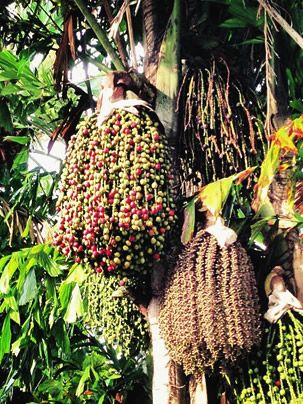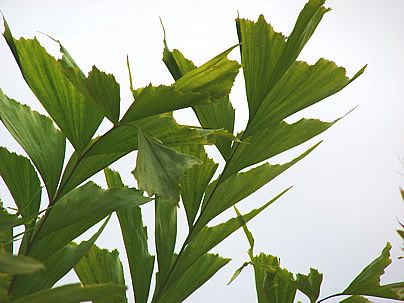The Burmese Fishtail Palm (Caryota mitis) is an ornamental species, with either a solitary stem or more commonly, multiple stems. Lacking a heart of palm, it reaches about 15 cm (approximately 6 inches) in diameter and forms dense clumps, up to 10 meters (about 33 feet) in height. The defining characteristic of this palm genus is the shape of its leaflets, resembling fish tails, hence its popular name.
Its leaves are bipinnate, light green, about 3 meters (nearly 10 feet) in length, with triangular, deeply serrated leaflets. It flowers consecutively, the first inflorescence emerging from the top of the plant, from the leaf axils, with each new inflorescence appearing lower down, descending towards the ground. The inflorescences are panicle type, with bisexual flowers ranging from green to cream in color. The subsequent fruits are globular, turning red and later black when ripe.
It is a monocarpic plant, growing for about 15 years or more before flowering. At the end of its long reproductive period, which may last a few more years, the fruit-bearing stem dies. However, as it is a clumping palm, the plant remains alive, renewing itself with each new lateral shoot.

With moderate to rapid growth, this medium-sized plant offers many landscaping functions. In the garden, it can be used as a focal point or backdrop, as a solitary palm or in clumps, also serving to enhance and soften structures. Its impressive and distinctive foliage is highly attractive, adding a tropical, exotic, and sophisticated touch.
Being densely clumping, it also serves as a privacy hedge, providing not only decorative effect but also noise reduction, pollution screening, or blocking views. Young plants are perfect as potted plants, decorating indoor spaces, patios, and balconies in residences or commercial rooms, malls, etc. It requires low maintenance, consisting of biannual fertilization and removal of old and damaged foliage. Dead stems should also be removed, but this is a task for every 18 years or more.
Curiosities: In its native countries, the Burmese Fishtail Palm has many traditional uses. The very young leaves can be used as a spicy vegetable, usually cooked and served with rice. A type of starch can be extracted from the trunk, which is used as sago.
The seeds are edible, after completely removing the poisonous pulp of the fruits, and the sap collected from the inflorescences is a rich syrup, which can be used to produce sugar and alcoholic beverages. Fibers extracted from the palm are also utilized in making furniture, crafts, etc.

This palm prefers semi-shade or even light shade locations, however, in humid climates, it also thrives in full sun. Young seedlings, however, should be protected from intense sun, which can slow growth and damage the beauty of the leaves, causing them to turn yellow and brown.
It is quite hardy and has no strong preference for soil type, as long as it is well-drained, but responds well to fertilizers, both organic and chemical, especially nitrogen-rich ones, contributing to rapid growth and a bright, vivid green color.
It is advisable to irrigate the Burmese Fishtail Palm in the first years of planting, avoiding the soil drying out completely between watering or rain. It does not tolerate prolonged drought periods. Preferring tropical climates, it can withstand light frosts.
Propagation is through seeds, obtained from ripe and depulped fruits, sown in a moist substrate, and more easily by division of clumps and shoots that spontaneously emerge around the mother plant. Seed germination occurs in about 3 to 4 months after planting.


